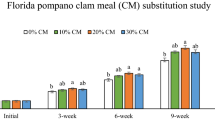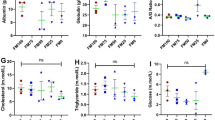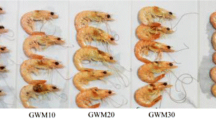Abstract
The effect of dietary supplementation of corn husk meal (CHM) on growth performance, liver antioxidant status and intestinal microbiota in Nile tilapia (Oreochromis niloticus) fingerlings was evaluated. Four experimental groups of fish with initial weight 0.47 ± 0.7 g in triplicate tanks were used; three of them were fed CHM incorporated diets (12.5 g/kg, DH12; 25 g/kg, DH25; and 50 g/kg, DH50), whereas a CHM-free basal diet served as control (DH0). No significant differences were observed in growth performance or feed efficiency in fish fed experimental diets (P > 0.05); however, fish fed the DH50 diet had a significant higher proportion of crude protein of whole-body composition (P < 0.05). Analysis of antioxidant enzyme activity showed significant differences (P < 0.05) with higher superoxide dismutase (SOD) activity in fish fed the DH25 diet, and lower glutathione peroxidase (GPx) activity in fish fed the DH12 diet. No significant differences were found in catalase (CAT) activity between treatments. Fusobacteria, Bacteroidetes and Proteobacteria were the most abundant phyla in all feces samples but no significant differences were found in microbial diversity among diets. Results suggest that CHM is safe for Nile tilapia consumption improving crude protein of whole-body composition and enhancing SOD activity.
Graphic Abstract



Similar content being viewed by others
References
FAO. US Department of Agriculture. World grain production. http://www.fao.org/faostat/ (2019). Accessed 20 Feb 2020
Li, H.Y., Xu, L., Liu, W.J., Fang, M.Q., Wang, N.: Assessment of the nutritive value of whole corn stover and its morphological fractions. Asian Austral. J. Anim. 27(2), 194 (2014). https://doi.org/10.5713/ajas.2013.13446
Ruan, Z., Wang, X., Liu, Y., Liao, W.: Corn. In: Pan, Z., Zhang, R., Zicari, S. (eds.) Integrated Processing Technologies for Food and Agricultural By-Products, pp. 59–72. Academic Press, Cambridge (2019). https://doi.org/10.1016/b978-0-12-814138-0.00003-4
Vazquez-Olivo, G., López-Martínez, L.X., Contreras-Angulo, L., Heredia, J.B.: Antioxidant capacity of lignin and phenolic compounds from corn stover. Waste Biomass Valori. 10, 95–102 (2019). https://doi.org/10.1007/s12649-017-0028-5
Galeana-López, J.A., Hernández, C., Leyva-López, N., Lizárraga-Velázquez, C.E., Sánchez-Gutiérrez, E.Y., Heredia, J.B.: Corn husk extracts as an antioxidant additive in diets for Nile tilapia (Oreochromis niloticus) fingerlings: effect on growth performance, feed intake and toxicity. Biotecnia 22(2), 147–154 (2020). https://doi.org/10.18633/biotecnia.v22i2.1256
Kurutas, E.B.: The importance of antioxidants which play the role in cellular response against oxidative/nitrosative stress: current state. Nutr. J. 15(1), 71 (2015). https://doi.org/10.1186/s12937-016-0186-5
Fairweather-Tait, S.J., Southon, S.: Bioavailability of nutrients. In: Caballero, B. (ed.) Encyclopedia of Food Sciences and Nutrition, pp. 478–484. Oxford Academic Press, Oxford (2003). https://doi.org/10.1016/B0-12-227055-X/00096-1
D’Archivio, M., Filesi, C., Di Benedetto, R., Gargiulo, R., Giovannini, C., Masella, R.: Polyphenols, dietary sources and bioavailability. Ann. Ist. Super Sanita 43(4), 348 (2007)
Manach, C., Scalbert, A., Morand, C., Remesy, C., Jimenez, L.: Polyphenols: food sources and bioavailability. Am. J. Clin. Nutr. 79, 727–747 (2004). https://doi.org/10.1093/ajcn/79.5.727
Liu, Z., Hu, M.: Natural polyphenol disposition via coupled metabolic pathways. Expert Opin. Drug. Metab. Toxicol. 3(3), 389–406 (2007). https://doi.org/10.1517/17425255.3.3.389
Burkitt, D.P., Walker, A.R.P., Painter, N.S.: Effect of dietary fibre on stools and transit-times, and its role in the causation of disease. Lancet 300(7792), 1408–1411 (1972). https://doi.org/10.1016/s0140-6736(72)92974-1
Gibson, G.R., Roberfroid, M.B.: Dietary modulation of the human colonic microbiota: introducing the concept of prebiotics. J. Nutr. 125(6), 1401–1412 (1995). https://doi.org/10.1093/jn/125.6.1401
Gibson, G.R.: Dietary modulation of the human gut microflora using prebiotics. British J. Nutr. 80(S2), S209–S212 (1998). https://doi.org/10.1017/S0007114500006048
Manning, T.S., Gibson, G.R.: Microbial-gut interactions in health and disease. Prebiotics. Best Pract. Res. Clin. Gastroenterol. 18(2), 287–298 (2004). https://doi.org/10.1016/j.bpg.2003.10.008
El-Mesallamy, A., Ahmad, M., Souleman, A., El Morsy, A., Abd El-Naby, A.: Effects of Roselle calyx (Hibiscussabdariffa L.)-supplemented diets on growth and disease (Aeromonashydrophila) resistance in Nile tilapia (Oreochromisniloticus L.). Egypt. Pharmaceut. J. 15, 78–87 (2016). https://doi.org/10.4103/1687-4315.190403
Armenta-López, G.E., Sumaya-Martínez, M.T., Spanopoulos-Hernández, M., Balois-Morales, R., Sánchez-Herrera, L.M., Jiménez-Ruíz, E.I.: Inclusion of natural antioxidant compounds in fish feeds to counteract oxidative stress. Rev. Bio Cienc. (2015). https://doi.org/10.15741/revbio.03.02.01
Abd El-Naby, A.S., Samir, F., Abdel Razek, N., Khattaby, A.A.: Effect of Aquaviance product as dietary supplementation to improve growth performance, feed intake, innate immunity and antioxidant activity for Nile tilapia, (Oreochromis niloticus). Abbassa Int. J. Aqua. 10(1), 114–138 (2017)
Welker, T.L., Lim, C.: Use of probiotics in diets of tilapia. J. Aquac. Res. Dev. S1, 014 (2011). https://doi.org/10.4172/2155-9546.S1-014
Sinha, A.K., Kumar, V., Makkar, H.P., De Boeck, G., Becker, K.: Non-starch polysaccharides and their role in fish nutrition–a review. Food Chem. 127(4), 1409–1426 (2011). https://doi.org/10.1016/j.foodchem.2011.02.042
FAO. Total Fishery Production. Fishery Statistics. Fishstat Plus. Electronic edition. http://www.fao.org/fishery/species/3217/en (2016). Accessed 20 February 2020.
Montoya-Camacho, N., Marquez-Ríos, E., Castillo-Yáñez, F.J., Cárdenas López, J.L., López-Elías, J.A., Ruíz-Cruz, S., Jiménez-Ruíz, E.I., Rivas-Vega, M.E., Ocaño-Higuera, V.M.: Advances in the use of alternative protein sources for tilapia feeding. Rev. Aquacult. 11, 515–526 (2019). https://doi.org/10.1111/raq.12243
Anderson, J., Jackson, A.J., Matty, A.J., Capper, B.S.: Effects of dietary carbohydrate and fiber on the tilapia (Oreochromis niloticus). Aquacult. 37, 303–414 (1984). https://doi.org/10.1016/0044-8486(84)90296-5
Singleton, V.L., Orthofer, R., Lamuela-Raventós, R.M.: Analysis of total phenols and other oxidation substrates and antioxidants by means of folin-ciocalteu reagent. Method. Enzymol. 299, 152–178 (1999). https://doi.org/10.1016/S0076-6879(99)99017-1
Brand-Williams, W., Cuvelier, M.E., Berset, C.: Use of a free radical method to evaluate antioxidant activity. LWT-Food Sci. Technol. 28, 25–30 (1995). https://doi.org/10.1016/S0023-6438(95)80008-5
AOAC. Official methods of analysis of AOAC International. In W. Horwitz (18th Ed.), Gaithersburg: International AOAC. (2011).
Ebeling, M.E.: The Dumas method for nitrogen in feeds. J. Assoc. Off. Anal. Chem 51, 766–770 (1968). https://doi.org/10.1093/jaoac/51.4.766
Bradford, M.M.: A rapid and sensitive method for the quantitation of microgram quantities of protein utilizing the principle of protein-dye binding. Anal. Biochem. 72(1–2), 248–254 (1976). https://doi.org/10.1016/0003-2697(76)90527-3
Azmat, M.A., Khan, I.A., Cheema, H.M.N., Rajwana, I.A., Khan, A.S., Khan, A.A.: Extraction of DNA suitable for PCR applications from mature leaves of Mangifera indica L. J. Zhejiang Univ. Sci. B. 13(4), 239–243 (2012). https://doi.org/10.1631/jzus.B1100194
Huse, S.M., Dethlefsen, L., Huber, J.A., Welch, D.M., Relman, D.A., Sogin, M.L.: Exploring microbial diversity and taxonomy using SSU rRNA hypervariable tag sequencing. PLoS Genet. 4(11), e1000255 (2008). https://doi.org/10.1371/journal.pgen.1000255
Navarro-Barrón, E., Hernández, C., Llera-Herrera, R., García-Gasca, A., Gómez-Gil, B.: Overfeeding a high-fat diet promotes sex-specific alterations on the gut microbiota of the Zebrafish (Danio rerio). Zebrafish. 16(3), 268–279 (2019). https://doi.org/10.1089/zeb.2018.1648
Martin, M.: Cutadapt removes adapter sequences from high-throughput sequencing reads. EMBnet. J. 17(1), 10–12 (2011). https://doi.org/10.14806/ej.17.1.200
Rognes, T., Flouri, T., Nichols, B., Quince, C., Mahé, F.: VSEARCH: a versatile open source tool for metagenomics. PeerJ. 4, e2584 (2016). https://doi.org/10.7717/peerj.2584
Yoon, S.H., Ha, S.M., Kwon, S., Lim, J., Kim, Y., Seo, H., Chun, J.: Introducing EzBioCloud: a taxonomically united database of 16S rRNA gene sequences and whole-genome assemblies. Int. J. Sys. Evol. Micr. 67(5), 1613 (2017). https://doi.org/10.1099/ijsem.0.001755
Yarza, P., Yilmaz, P., Pruesse, E., Glöckner, F.O., Ludwig, W., Schleifer, K.H., Rosselló-Móra, R.: Uniting the classification of cultured and uncultured bacteria and archaea using 16S rRNA gene sequences. Nat. Rev. Microbiol. 12(9), 635–645 (2014). https://doi.org/10.1038/nrmicro3330
Zar, J.H.: Biostatistical analysis. Prentice-Hall, Englewood Cliffs (1984)
Naveed, M., Hejazi, V., Abbas, M., Kamboh, A.A., Khan, G.J., Shumzaid, M., WenHua, L.: Chlorogenic acid (CGA): a pharmacological review and call for further research. Biomed. Pharmacother. 97, 67–74 (2018). https://doi.org/10.1016/j.biopha.2017.10.064
Yu, L.-J., Wu, F., Jiang, M., Yang, C.-G., Liu, W., Tian, J., Lu, X., Wen, H.: Ferulic acid: a natural compound as an efficient feed additive for GIFT (Oreochromis niloticus). Aquac. Nutr. 24, 27–35 (2017). https://doi.org/10.1111/anu.12529
Ringø, R., Olsen, R.E., Gifstad, T.Ø., Dalmo, R.A., Amlund, H., Hemre, G.-I., Bakke, A.M.: Prebiotics in aquaculture: a review. Aquac. Nutr. 16(2), 117–136 (2010). https://doi.org/10.1111/j.1365-2095.2009.00731.x
Van Doan, H., Hoseinifar, S.H., Tapingkae, W., Seel-audom, M., Jaturasitha, S., Dawood, M.A.O., Esteban, M.Á.: Boosted growth performance, mucosal and serum immunity, and disease resistance Nile tilapia (Oreochromis niloticus) fingerlings using corncob-derived xylooligosaccharide and Lactobacillus plantarum CR1T5. Probiotics Antimicrob. Proteins. (2019). https://doi.org/10.1007/s12602-019-09554-5[28]
Ighodaro, O.M., Akinloye, O.A.: First line defense antioxidants-superoxide dismutase (SOD), catalase (CAT) and glutathione peroxidase (GPX): their fundamental role in the entire antioxidant defense grid. Alexandria J. Med. 54(4), 287–293 (2018). https://doi.org/10.1016/j.ajme.2017.09.001
Miao, L., Clair, D.K.S.: Regulation of superoxide dismutase genes: implications in disease. Free Radical Bio. Med. 47(4), 344–356 (2009). https://doi.org/10.1016/j.freeradbiomed.2009.05.018
Lopes, J.M., de Freitas Souza, C., Saccol, E.M.H., Pavanato, M.A., Antoniazzi, A., Rovani, M.T., Baldisserotto, B.: Citrus x aurantium essential oil as feed additive improved growth performance, survival, metabolic, and oxidative parameters of silver catfish (Rhamdia quelen). Aquac. Nutr. 25(2), 310–318 (2019). https://doi.org/10.1111/anu.12854
Lizárraga-Velázquez, C.E., Hernández, C., González-Aguilar, G.A., Heredia, J.B.: Effect of dietary intake of phenolic compounds from mango peel extract on growth, lipid peroxidation and antioxidant enzyme activities in zebrafish (Danio rerio). Lat. Am. J. Aquat. Res. 47, 602–611 (2019). https://doi.org/10.3856/vol47-issue4-fulltext-3
Vicente, I.S., Fleuri, L.F., Carvalho, P.L., Guimarães, M.G., Naliato, R.F., Müller, H.D.C., Barros, M.M.: Orange peel fragment improves antioxidant capacity and haematological profile of Nile tilapia subjected to heat/dissolved oxygen-induced stress. Aquac. Res. 50(1), 80–92 (2019). https://doi.org/10.1111/are.13870
Ray, C., Bujan, N., Tarnecki, A., Davis, A.D., Browdy, C., Arias, C.R.: Analysis of the gut microbiome of Nile tilapia Oreochromisniloticus L. fed diets supplemented with Previda® and saponin. J Fish Sci 11(2), 36 (2017). https://doi.org/10.21767/1307-234X.1000116
Yuji-Sado, R., Raulino-Domanski, F., de Freitas, P.F., Baioco-Sales, F.: Growth, immune status and intestinal morphology of Nile tilapia fed dietary prebiotics (mannan oligosaccharides-MOS). Lat. Am. J. Aquat. Res. 43(5), 944–952 (2015). https://doi.org/10.3856/vol43-issue5-fulltext-14
de Souza, F.P., de Lima, C.S., Urrea-Rojas, A.M., Suphoronski, S.A., Facimoto, C.T., Júnior, J.D.S.B., Lopera-Barrero, N.M.: Effects of dietary supplementation with a microalga (Schizochytrium sp.) on the hemato-immunological, and intestinal histological parameters and gut microbiota of Nile tilapia in net cages. PLoS ONE 15(1), 1–19 (2020). https://doi.org/10.1371/journal.pone.0226977
Janda, J.M., Abbott, S.L., McIver, C.J.: Plesiomonas shigelloides revisited. Clin. Microbiol. Rev. 29(2), 349–374 (2016). https://doi.org/10.1128/CMR.00103-15
Sierralta, C., Mayta, H., León, Q.: First report of Plesiomonas shigelloides as opportunistic pathogen in tilapia Oreochromis niloticus (Linnaeus, 1758) in a fish farm in Lima, Peru. Rev. de Investig Vet. del Perú (RIVEP). 27(3), 565–572 (2016). https://doi.org/10.15381/rivep.v27i3.11996
Liu, Z., Ke, X., Lu, M., Gao, F., Cao, J., Zhu, H., Wang, M.: Identification and pathological observation of a pathogenic Plesiomonas shigelloides strain isolated from cultured tilapia (Oreochromis niloticus). Acta Microbiol. Sin. 55(1), 96–106 (2015)
Yilmaz, S.: Effects of dietary blackberry syrup supplement on growth performance, antioxidant, and immunological responses, and resistance of Nile tilapia, Oreochromis niloticus to Plesiomonas shigelloides. Fish Shellfish Immun. 84, 1125–1133 (2019). https://doi.org/10.1016/j.fsi.2018.11.012
Acknowledgements
Funding was provided by Consejo Nacional de Ciencia y Tecnología (CONACyT) Grant 292474. The authors wish to acknowledge the CONACyT for the graduate scholarship 552436 Granted to José Andres Galeana Lopez. This manuscript is part of the activities of the Thematic Network 12.3: to reduce and valorize the losses and the waste of food systems Project 294768 and it is part of Cátedras-CONACYT Project #729: Applied biotechnologies for the development of functional foods for aquaculture. The authors are grateful to Karen Enciso-Ibarra, Erika Yazmin Sánchez-Gutiérrez, María del Carmen Bolan-Mejia, Nancy Vera-Rivera, Cecilia Cervantes-Briseño and Susanna Janette Gurrola for technical support.
Author information
Authors and Affiliations
Corresponding author
Ethics declarations
Conflict of interest
The authors declare no conflict of interest.
Research involving human and animal rights
The authors followed all applicable international, national and/or institutional guidelines for the care and use of animals.
Additional information
Publisher's Note
Springer Nature remains neutral with regard to jurisdictional claims in published maps and institutional affiliations.
Supplementary Information
Below is the link to the electronic supplementary material.
Rights and permissions
About this article
Cite this article
Galeana-López, J.A., Gómez-Gil, B., Hernández, C. et al. Use of Corn Husk Meal in the Development of a Functional Diet for Nile tilapia (Oreochromis niloticus) Fingerlings: Effect on Growth Performance, Antioxidant Status and Intestinal Microbiota. Waste Biomass Valor 12, 4355–4365 (2021). https://doi.org/10.1007/s12649-020-01314-9
Received:
Accepted:
Published:
Issue Date:
DOI: https://doi.org/10.1007/s12649-020-01314-9




